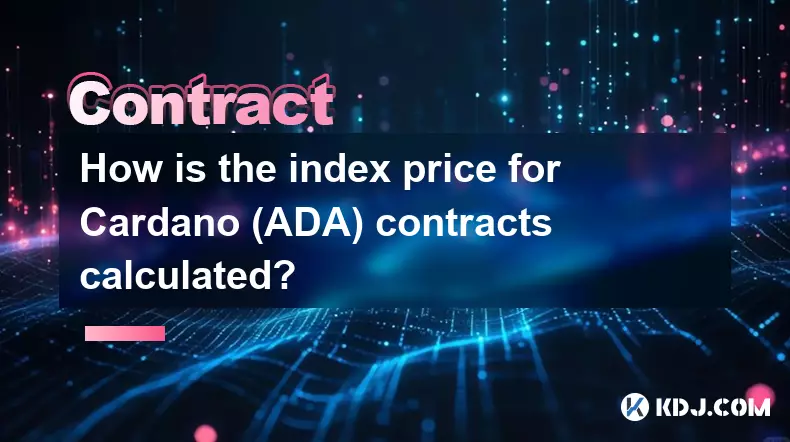-
 bitcoin
bitcoin $122090.672462 USD
1.59% -
 ethereum
ethereum $4493.758974 USD
0.56% -
 xrp
xrp $3.033145 USD
0.65% -
 tether
tether $1.000629 USD
0.00% -
 bnb
bnb $1169.854250 USD
7.07% -
 solana
solana $230.954786 USD
-0.19% -
 usd-coin
usd-coin $0.999785 USD
0.00% -
 dogecoin
dogecoin $0.256108 USD
-1.12% -
 tron
tron $0.342333 USD
-0.12% -
 cardano
cardano $0.859632 USD
-0.10% -
 hyperliquid
hyperliquid $48.932146 USD
-2.25% -
 chainlink
chainlink $22.345466 USD
-1.29% -
 ethena-usde
ethena-usde $1.000217 USD
-0.03% -
 avalanche
avalanche $31.203456 USD
1.93% -
 sui
sui $3.579145 USD
1.05%
How is the index price for Cardano (ADA) contracts calculated?
The ADA index price is a volume-weighted, multi-exchange average filtered for outliers, ensuring fair and stable pricing for derivatives trading.
Oct 01, 2025 at 11:18 pm

Understanding the Index Price for Cardano (ADA) Contracts
1. The index price for Cardano (ADA) futures and perpetual contracts is derived from a composite average of ADA/USD or ADA/USDT trading pairs across multiple major cryptocurrency exchanges. This method ensures that no single exchange can disproportionately influence the valuation, reducing manipulation risks. Exchanges typically included in this calculation are Binance, Coinbase, Kraken, Bybit, and OKX, among others, depending on the derivative platform's data sources.
2. Data feeds from these exchanges are collected at regular intervals—usually every few seconds—and then weighted based on trading volume and liquidity. High-volume markets contribute more significantly to the final index value. This volume-weighted approach enhances accuracy by prioritizing markets with deeper order books and tighter spreads.
3. Before inclusion in the index, outlier prices are filtered using statistical methods such as median selection or trimmed averages. For instance, if one exchange shows a sudden spike due to a large trade or technical error, it may be excluded from the calculation to maintain stability and fairness in pricing.
4. The resulting index price serves as a benchmark for marking positions to market, calculating unrealized P&L, and triggering liquidations. It prevents scenarios where a trader could be unfairly liquidated due to temporary price deviations on a single exchange.
Role of Oracles and Data Aggregation
1. Most derivatives platforms rely on decentralized or centralized oracle systems to pull real-time price data. Platforms like Chainlink or proprietary oracle networks aggregate data from API endpoints of supported exchanges, ensuring low latency and high reliability.
2. These oracles apply time-weighted average price (TWAP) mechanisms over short intervals—often 30 seconds to 5 minutes—to smooth out flash crashes or pump-and-dump attempts. This adds another layer of protection against short-term volatility distorting the index.
3. Some platforms use dual-layer validation: initial aggregation followed by cross-verification with secondary data providers. If discrepancies exceed a predefined threshold, alerts are triggered, and manual or automated intervention may occur to reassess data integrity.
This multi-source, volume-weighted, and anomaly-filtered methodology ensures the ADA index price remains resilient and representative of true market conditions.Impact on Derivatives Trading Mechanics
1. The index price directly influences margin requirements and liquidation engines. When the mark price diverges significantly from the last traded price, funding rates adjust accordingly to bring equilibrium between long and short positions.
2. In perpetual swap contracts, funding payments are calculated using the difference between the contract’s last traded price and the index price. This mechanism discourages sustained premium or discount trading relative to fair market value.
3. During periods of high volatility—such as network upgrades or macroeconomic events—the index price helps stabilize trading by preventing cascading liquidations driven by isolated exchange anomalies.
4. Traders relying on arbitrage strategies must account for index price behavior, especially when executing cross-exchange trades involving ADA futures. Misalignment between spot prices and the index can create temporary opportunities but also carry execution risk.
Transparency and Trust in Index Formation
1. Leading crypto derivatives exchanges publish detailed methodologies outlining which exchanges contribute data, how weights are assigned, and what filters are applied. This transparency allows traders to verify assumptions and assess potential biases.
2. Independent audits or third-party verification of price feeds enhance credibility. Some platforms provide real-time dashboards showing raw input prices and the computed index, enabling users to monitor discrepancies.
3. Community feedback often leads to refinements in the index formula, such as adding new exchanges or adjusting weighting algorithms. Responsiveness to user concerns strengthens trust in the system’s fairness.
A well-constructed index price reflects not just mathematical rigor but also operational resilience and alignment with market dynamics.Frequently Asked Questions
How often is the ADA index price updated?The index price is typically refreshed every 1 to 5 seconds, depending on the exchange. High-frequency updates ensure responsiveness to live market movements while maintaining computational efficiency.
Can the index price be manipulated?While theoretically possible, coordinated manipulation across multiple high-volume exchanges simultaneously is extremely costly and unlikely. The use of volume weighting, outlier filtering, and oracle safeguards makes successful manipulation highly improbable.
What happens if an exchange goes offline?If a contributing exchange becomes unreachable, its data is either replaced with historical averages or excluded temporarily. The remaining exchanges continue to feed the index, preserving functionality without compromising overall accuracy.
Do different platforms calculate the ADA index the same way?No. Each derivatives platform has its own proprietary model, though most follow similar principles: multi-exchange aggregation, volume weighting, and anomaly detection. Traders should review individual exchange documentation to understand specific implementation details.
Disclaimer:info@kdj.com
The information provided is not trading advice. kdj.com does not assume any responsibility for any investments made based on the information provided in this article. Cryptocurrencies are highly volatile and it is highly recommended that you invest with caution after thorough research!
If you believe that the content used on this website infringes your copyright, please contact us immediately (info@kdj.com) and we will delete it promptly.
- BlockDAG, DOGE, HYPE Sponsorship: Crypto Trends Shaping 2025
- 2025-10-01 00:25:13
- Deutsche Börse and Circle: A StableCoin Adoption Powerhouse in Europe
- 2025-10-01 00:25:13
- BlockDAG's Presale Buzz: Is It the Crypto to Watch in October 2025?
- 2025-10-01 00:30:13
- Bitcoin, Crypto, and IQ: When Genius Meets Digital Gold?
- 2025-10-01 00:30:13
- Stablecoins, American Innovation, and Wallet Tokens: The Next Frontier
- 2025-10-01 00:35:12
- NBU, Coins, and Crypto in Ukraine: A New Yorker's Take
- 2025-10-01 00:45:14
Related knowledge

What is the difference between futures and perpetual contracts for Bitcoin?
Oct 02,2025 at 11:54pm
Understanding Bitcoin Futures Contracts1. Bitcoin futures are derivative instruments that allow traders to speculate on the future price of Bitcoin at...

What is the best time to trade PEPE contracts?
Oct 03,2025 at 11:54am
Understanding PEPE Contract Volatility1. PEPE contracts exhibit extreme price fluctuations due to their meme-based nature and low market cap. Trading ...

What are the common mistakes to avoid with Bitcoincoin contracts?
Oct 03,2025 at 08:54am
Emerging Trends in the Cryptocurrency Market1. Decentralized finance (DeFi) platforms continue to expand their influence across the blockchain ecosyst...

What is the maintenance margin for Bitcoin contracts?
Oct 02,2025 at 01:36am
Decentralized Exchanges Gain Momentum in 20241. Decentralized exchanges (DEXs) have seen a significant rise in trading volume, surpassing centralized ...

How to use technical analysis for trading XRP contracts?
Oct 03,2025 at 01:18pm
Understanding Price Patterns in XRP Futures1. Identifying chart patterns such as triangles, head and shoulders, and double tops or bottoms can provide...

What does "longing" PEPE contracts mean?
Oct 03,2025 at 11:54pm
Understanding Decentralized Exchanges in the Crypto Ecosystem1. Decentralized exchanges (DEXs) operate without a central authority, allowing users to ...

What is the difference between futures and perpetual contracts for Bitcoin?
Oct 02,2025 at 11:54pm
Understanding Bitcoin Futures Contracts1. Bitcoin futures are derivative instruments that allow traders to speculate on the future price of Bitcoin at...

What is the best time to trade PEPE contracts?
Oct 03,2025 at 11:54am
Understanding PEPE Contract Volatility1. PEPE contracts exhibit extreme price fluctuations due to their meme-based nature and low market cap. Trading ...

What are the common mistakes to avoid with Bitcoincoin contracts?
Oct 03,2025 at 08:54am
Emerging Trends in the Cryptocurrency Market1. Decentralized finance (DeFi) platforms continue to expand their influence across the blockchain ecosyst...

What is the maintenance margin for Bitcoin contracts?
Oct 02,2025 at 01:36am
Decentralized Exchanges Gain Momentum in 20241. Decentralized exchanges (DEXs) have seen a significant rise in trading volume, surpassing centralized ...

How to use technical analysis for trading XRP contracts?
Oct 03,2025 at 01:18pm
Understanding Price Patterns in XRP Futures1. Identifying chart patterns such as triangles, head and shoulders, and double tops or bottoms can provide...

What does "longing" PEPE contracts mean?
Oct 03,2025 at 11:54pm
Understanding Decentralized Exchanges in the Crypto Ecosystem1. Decentralized exchanges (DEXs) operate without a central authority, allowing users to ...
See all articles










































































